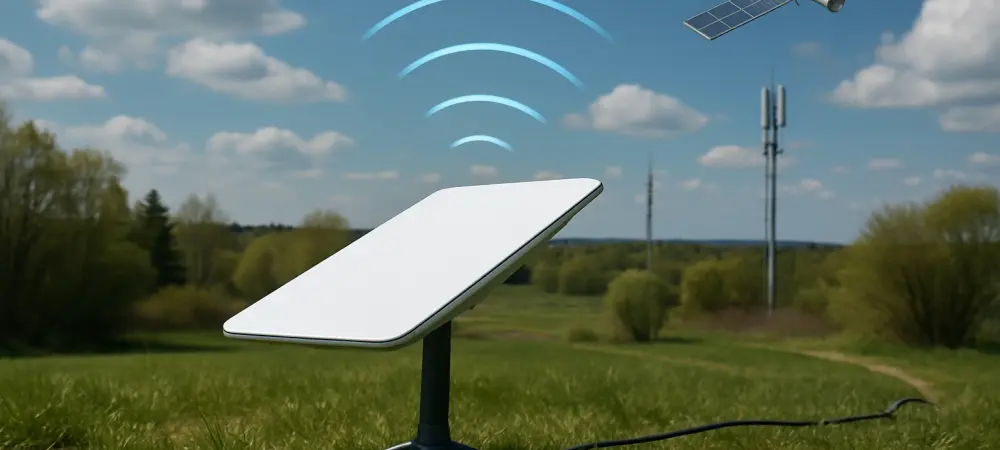Pioneering a Connected World: Why This Matters
Imagine a world where a farmer in a remote valley can stream real-time agricultural data, or a disaster-stricken community can coordinate rescue efforts without the hindrance of downed cell towers. This scenario is no longer a distant dream but a tangible reality taking shape through the strategic partnership between SpaceX’s Starlink and EchoStar. Their collaboration, centered on satellite-driven 5G connectivity, is poised to redefine the telecommunications market by eliminating geographic barriers to mobile access. This market analysis explores the implications of their innovative Direct to Cell service, delving into current trends, data-driven insights, and future projections for global connectivity. The stakes are high as this alliance challenges traditional infrastructure models, promising to reshape how billions access mobile networks.
Market Dynamics and Emerging Trends in Satellite Connectivity
The Rise of Low Earth Orbit Networks
The telecommunications sector is witnessing a seismic shift with the rapid adoption of low Earth orbit (LEO) satellite networks, a trend exemplified by Starlink’s expansive infrastructure. Operating over 600 satellites at approximately 360 kilometers above Earth, Starlink currently serves more than six million users globally, a figure that underscores the growing demand for non-terrestrial connectivity solutions. Unlike traditional geostationary satellites, LEO systems offer reduced latency and enhanced bandwidth, making them ideal for real-time applications like video calls and data streaming. This technological edge is driving investment in satellite-based communication, with market reports indicating a surge in funding for LEO projects as telecom giants seek alternatives to costly ground-based networks.
Strategic Partnerships Fueling 5G Innovation
A critical driver of market growth is the strategic alliance between Starlink and EchoStar, particularly through their focus on spectrum acquisition to bolster 5G capabilities. EchoStar’s contribution of spectrum resources has been likened to constructing a vast “airwave highway,” enabling each new satellite to handle 20 times more data and boosting overall system capacity by a factor of 100. This positions the partnership to transition from basic connectivity to a comprehensive 5G experience, a move that could capture significant market share in regions lacking traditional infrastructure. However, regulatory challenges over spectrum allocation and competition from other satellite providers like Amazon’s Kuiper Systems pose risks to this ambitious rollout.
Addressing Underserved Markets and Emergency Needs
Another pivotal trend is the targeting of underserved and remote markets, where satellite connectivity offers a unique value proposition. The Direct to Cell service, which delivers signals directly to standard mobile phones without specialized hardware, has already demonstrated impact, with over 1.5 million individuals in the US relying on it during natural disasters when ground networks failed. This capability not only addresses everyday connectivity gaps but also positions satellite technology as a digital safety net in crises, influencing market demand in sectors like emergency response and rural development. As costs decline and reliability improves, adoption in developing regions is expected to accelerate, further expanding the market footprint of such innovations.
Data Insights and Market Projections for Satellite 5G
Current Performance Metrics and User Adoption
Analyzing current data reveals the transformative potential of Starlink’s satellite network in the telecom market. With a user base exceeding six million, the platform’s growth trajectory reflects a robust appetite for alternative connectivity solutions, particularly in areas where terrestrial networks are impractical. Testing of the Direct to Cell service, initiated over a year ago, has progressed from basic text messaging to enabling complex interactions like video calls from space, showcasing technological maturity. Market analysts estimate that satellite-based services could penetrate up to 15% of the global mobile connectivity market by 2027, driven by declining launch costs and enhanced data handling capabilities.
Forecasting Growth and Economic Impacts
Looking ahead, projections suggest that the Starlink-EchoStar partnership could redefine economic models within the telecommunications industry. The integration of SpaceX’s Starship rocket for rapid satellite deployment offers a cost-effective scalability that traditional providers struggle to match, potentially reducing per-user connectivity costs by 30% over the next few years. This economic advantage is likely to spur adoption in price-sensitive markets, particularly in developing economies where mobile penetration remains low. Furthermore, the shift to a full 5G experience via satellite is anticipated to unlock new revenue streams in sectors like IoT, agriculture, and logistics, where real-time data access is critical.
Competitive Landscape and Potential Barriers
Despite optimistic forecasts, the competitive landscape presents notable challenges that could temper growth. Rival satellite constellations are vying for market share, while regulatory frameworks surrounding spectrum usage remain inconsistent across regions, potentially delaying global expansion. Additionally, urban environments with obstructed satellite views may limit service reliability, necessitating hybrid solutions that integrate terrestrial and non-terrestrial networks. Market observers note that overcoming these hurdles will require not only technological innovation but also diplomatic efforts to secure international agreements on spectrum allocation and operational standards.
Reflecting on Market Shifts and Strategic Pathways
Looking back, the alliance between Starlink and EchoStar marked a turning point for the telecommunications industry, highlighting the untapped potential of satellite-driven 5G connectivity. Their efforts to bridge digital divides through the Direct to Cell service demonstrated a viable alternative to traditional infrastructure, particularly in emergency and remote scenarios. For industry stakeholders, the path forward involves strategic investments in hybrid network solutions to address urban coverage gaps, alongside advocacy for streamlined regulatory policies to facilitate global rollout. Businesses in adjacent sectors, such as disaster management and rural development, are encouraged to explore partnerships with satellite providers to leverage this technology for operational resilience. Ultimately, the journey underscores a broader imperative to prioritize equitable access, ensuring that the benefits of connectivity reach every corner of the globe.

